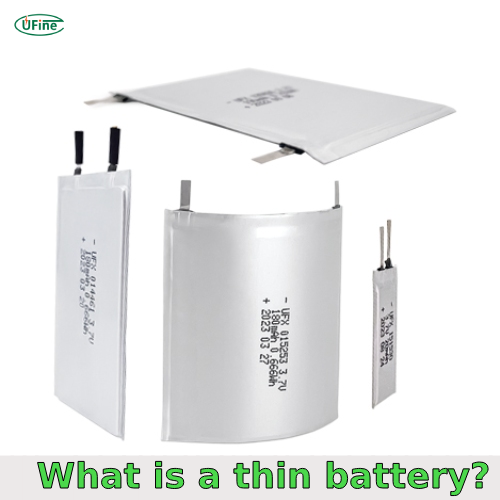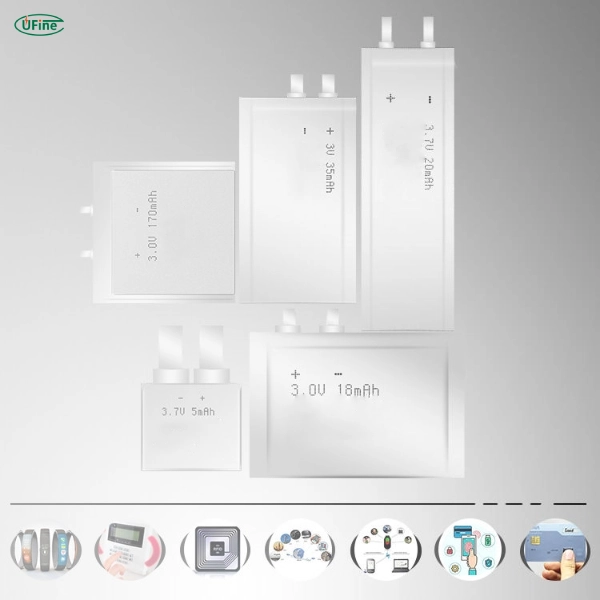Have you ever wondered what a thin battery is and how it works? This article thoroughly explores thin battery design, features, usage, and customization. It offers a comprehensive understanding of these compact power sources, covering topics from their construction to applications. Let’s delve into the world of thin batteries and uncover their practical applications in various fields.
Part 1. What is a thin battery?
Definition:
Thin batteries are compact power sources designed for devices with limited space. Their slim profile and lightweight construction characterize them. These batteries typically consist of layers of electrodes, electrolytes, and separators arranged in a compact structure.
Importance in Modern Technology:
Thin batteries are pivotal in modern electronic devices, enabling sleek and compact designs without compromising functionality. Manufacturers widely use them in various products, including smart cards, wearable devices like fitness trackers and smartwatches, medical implants, and IoT sensors. Their compact size and efficient power delivery make them indispensable in today’s technology landscape.
Part 2. Thin battery design and construction
Regarding the design and construction of thin batteries, several key factors contribute to their unique characteristics and functionality.
Slim Profile:
- Our design team meticulously crafts thin batteries to be exceptionally thin, often measuring only between 0.1 to 5 millimeters in thickness.
- We achieve this slim profile through careful selection of materials and manufacturing processes that minimize the overall size of the battery.
- Advanced engineering techniques, such as thin film deposition and microfabrication, enable the creation of thin batteries with previously thought impossible dimensions.
Flexible Substrates:
- One of the most distinctive features of thin batteries is their use of flexible substrates, which serve as the foundation for the battery’s construction.
- These substrates are typically made from polyimide, PET (polyethylene terephthalate), or thin metal foils such as aluminum or copper.
- The flexibility of these substrates allows the battery to conform to the contours of the device it powers, making them suitable for applications where space is limited or irregularly shaped.
Component Integration:
Thin batteries have several integrated components, each playing a crucial role in the battery’s function.
- Electrodes: Thin batteries typically feature anode and cathode materials, such as lithium cobalt oxide or lithium iron phosphate, deposited onto the flexible substrate.
- Electrolytes: These are usually in the form of a gel or liquid containing ions that facilitate the movement of charge between the electrodes during the battery’s charge and discharge cycles.
- Separators: Thin batteries employ separators made from porous materials like polyethylene or ceramic, which prevent direct contact between the electrodes while allowing the flow of ions.
Manufacturing Techniques:
Producing thin batteries involves sophisticated manufacturing techniques tailored to their unique requirements.
- Roll-to-roll printing: This method involves continuously depositing thin layers of battery materials onto a flexible substrate, allowing for high throughput and cost-effective production.
- Screen printing: Screen printing techniques apply battery materials onto the substrate in precise patterns, enabling the customization of battery designs for specific applications.
- Vapor deposition: Manufacturers utilize vapor deposition processes to deposit thin films of electrode materials onto the substrate with exceptional precision, resulting in batteries with high energy density and performance.
Part 3. Critical features of thin batteries
Thin batteries boast several vital features that make them highly sought after in various applications:
- Compactness: The ultra-thin form factor of these batteries allows for seamless integration into various devices, including wearables, medical implants, Internet of Things (IoT) devices, and smart cards.
- Flexibility: Designers can craft thin batteries to be flexible, enabling them to conform to curved or irregularly shaped surfaces. This flexibility opens up new possibilities for device design and enhances user comfort.
- High Energy Density: Despite their small size, thin batteries offer impressive energy density. This means they can store significant energy relative to their size, ensuring prolonged device operation without frequent recharging.
- Quick Recharge: Thin batteries are designed for fast charging, minimizing downtime and allowing users to get back to using their devices quickly.
- Long Cycle Life: These batteries exhibit excellent cycle life, meaning they can withstand numerous charge and discharge cycles without significant degradation in performance. This longevity contributes to their overall cost-effectiveness.
- Safe and Environmentally Friendly: Thin batteries are typically constructed using non-toxic and environmentally friendly materials, reducing the risk of hazards and making them more sustainable than traditional battery types.
Part 4. Applications of thin batteries
Wearable Technology:
- Manufacturers extensively use thin batteries in wearable devices such as fitness trackers, smartwatches, and wearables.
- Their compact size and lightweight design make them ideal for powering wearable gadgets without adding bulk or weight.
Smart Cards and RFID Tags:
- Manufacturers commonly employ thin batteries in smart cards and RFID tags for various applications, including access control, payment systems, and inventory management.
- Their slim profile allows for integration into cards and tags without compromising functionality or usability.
Medical Devices:
- Thin batteries are crucial in medical devices such as implantable medical devices, drug delivery systems, and wearable health monitors.
- Their small form factor and flexibility enable them to power medical devices discreetly and comfortably for patients.
Internet of Things (IoT) Sensors:
- Thin batteries are essential power sources for IoT sensors deployed in smart homes, industrial automation, agriculture, and environmental monitoring.
- Their long lifespan, high energy density, and quick recharge capability make them suitable for powering IoT sensors in remote or hard-to-reach locations.
Consumer Electronics:
- Manufacturers widely use thin batteries in various consumer electronics products, including smartphones, tablets, laptops, and digital cameras.
- Their high energy density and quick recharge feature ensure optimal performance and user convenience in electronic devices.
Flexible Displays and Electronic Paper:
- Manufacturers integrate thin batteries into flexible displays and electronic paper devices to power screen illumination and image refresh.
- Their flexibility allows them to conform to flexible displays’ curved or bendable surfaces, enabling innovative design possibilities.
Smart Packaging:
- Manufacturers employ thin batteries in intelligent packaging solutions for product authentication, tamper detection, and interactive marketing.
- Their compact size and long lifespan make them suitable for powering electronic components embedded in product packaging.
Military and Aerospace Applications:
- Manufacturers utilize thin batteries in military and aerospace applications such as uncrewed aerial vehicles (UAVs), portable communication devices, and soldier-worn equipment.
- Their lightweight design and high energy density meet the stringent requirements of military and aerospace environments.
Part 5. Thin battery customization
Shape and Size:
- We can customize thin batteries to fit specific shapes and sizes required by different devices.
- We produce thin batteries in various dimensions to accommodate the design constraints of electronic products.
Capacity:
- We provide customization options for adjusting the capacity of thin batteries based on the power requirements of the device that will utilize them.
- Our engineers can modify the thickness and composition of the electrodes and electrolytes to meet specific capacity needs.
Voltage:
- We provide customization services to adjust the voltage output of thin batteries to match the requirements of electronic components.
- Our team can modify the number and arrangement of battery cells to achieve the desired voltage.
Connectivity:
- We offer customization options for easy integration into electronic devices, including different connectors or terminals on thin batteries.
- Our engineers can add connectors such as solder tabs, wire leads, or flex circuits to facilitate the connection between the battery and the device.
Packaging:
- We offer various packaging options to customize thin batteries and enhance their durability and safety.
- Our team can encapsulate thin batteries in protective casings or coatings to shield them from environmental factors such as moisture, dust, and mechanical damage.
Temperature Range:
- We provide customization services to ensure thin batteries operate within specific temperature ranges and meet the requirements of different applications.
- Our engineers optimize the battery’s chemistry and design to ensure reliable performance in extreme hot or cold temperatures.
Special Features:
- We offer customization options to incorporate unique features into thin batteries, such as built-in protection circuits, wireless charging capabilities, or low self-discharge rates.
- Our team can add additional functionalities to enhance the performance and user experience of thin batteries in specific applications.
Branding and Labeling:
- We provide customization services to imprint branding elements, logos, or labels on thin batteries to reflect the identity of the device manufacturer or brand.
- Our team can imprint logos or labels on the battery’s surface using printing or laser engraving techniques.
Part 6. FAQs
-
What are the factors to consider when choosing thin batteries?
When selecting thin batteries, it’s essential to consider factors such as power requirements, size constraints, operating environment, and desired features. -
Are thin batteries safe to use?
Yes, thin batteries are designed with safety features to prevent accidents and ensure reliable operation. -
What is the lifespan of thin batteries?
Generally, thin batteries have a long lifespan of thousands of charge cycles, providing reliable power for extended periods. -
Are there any limitations to the use of thin batteries?
While thin batteries offer numerous advantages, they may have limitations regarding maximum power output, temperature range, and compatibility with specific devices or applications.
Related Tags:
More Articles

LiPo Battery Discharge Rate Guide & Calculation Tips
Understand LiPo battery discharge rates, C-ratings, and how to calculate max current. Essential guide for RC, drones, and electronics users.
High‑Capacity 3S LiPo Batteries: 5000 mAh vs. 10000 mAh
Compare 3S LiPo 5000mAh vs 10000mAh batteries by weight, power, and use. Find the best fit for your drone, RC car, or boat setup.
Top 5 Applications for Small 3S LiPo Batteries
Small 3S LiPo batteries power drones, RC gear, wearables, and robotics with high energy and low weight. Making them ideal for compact electronics projects.
Building and Charging Your Own 3S LiPo Pack: A Step‑by‑Step Guide
Learn how to build, balance, and charge a 3S LiPo battery pack safely at home with this complete DIY guide for hobbyists and beginners.
How to Choose the Right LiPo Battery Plug Type?
Discover the best LiPo battery plug types, how to choose them, and expert tips for safe usage, soldering, and maintenance.





